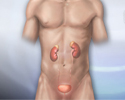Urinary incontinence products - self-care
Adult diapers; Disposable urinary collection devices
If you have problems with urinary incontinence (leakage), wearing special products will keep you dry and help you avoid embarrassing situations.
Choosing the Right Product
First, talk with your health care provider to make sure the cause of your leakage cannot be treated.
There are many types of urinary incontinence products that you can buy. These products help keep your skin dry and prevent skin rashes and sores.
Ask your provider which product might be best for you. It depends on how much leakage you have and when it happens. You might also be concerned about cost, odor control, comfort, and how easy the product is to use.
You can always try another product if the one you are using is uncomfortable or does not keep you dry enough.
Your provider might ask you to drink less fluid throughout the day to cut down on leakage. Your provider may also recommend using the bathroom at regular, set times to help avoid accidents. Keeping a journal about when you have leakage problems can help your provider treat you.
Products for Men and Women
You can wear disposable pads in your underwear. They have a waterproof backing that keeps your clothes from getting wet. Common brands are:
- Attends
- Abena
- Depends
- Poise
- Reassure
- Serenity
- Tena
- Tranquility
- Many different store brands
Always change your pad or underwear regularly, even if you are dry. Changing often will keep your skin healthy. Set aside time to change 2 to 4 times a day at the same times every day.
Adult Diapers and Underwear
You can use adult diapers if you are leaking large amounts of urine. You can buy the kind that you use once and throw away, or ones that you can wash and reuse. They come in different sizes. Wear a size that fits you snugly. Some have elastic around the legs to keep from leaking onto your clothes. Some come with a plastic cover for more protection.
Special, washable underwear are also available. These look more like regular underwear than adult diapers. Some have a waterproof crotch area and room for a pad or liner. Some are made out of a special waterproof fabric that keeps your skin dry. You do not need a pad with these.
Waterproof outer pants made of nylon, vinyl, or rubber are also available. They can be worn over your underwear.
Special Products for Men
Men can use a drip collector for small amounts of urine leakage. This is a small pocket that fits over the penis. Wear close-fitting underwear to keep it in place.
Men can also use a condom catheter device. It fits over the penis like a condom. A tube carries the urine that collects in it to a bag attached to the leg. This helps to prevent odor and skin problems.
Special Products for Women
Women can try different products, depending on the cause for their urine leakage. External devices include:
- Foam pads that are very small and fit between your labia. You take the pad out when you need to urinate, and then put a new one in. Common brands are Miniguard, UroMed, Impress, and Softpatch.
- A urethra cap is a silicone cap, or shield that fits in place over your urinary opening. It can be washed and used again. Common brands are CapSure and FemAssist.
Internal devices to prevent urine leakage include:
- A single-use plastic shaft that can be inserted into your urethra (hole where urine comes out) and has a balloon on one end and a tab on the other. It is only for single, short-term use and needs to be removed to urinate. Common brands are Reliance and FemSoft.
- A pessary is a round latex or silicone disk that is inserted into your vagina to provide bladder support. It needs to be removed and washed on a regular basis. It must be fitted and prescribed by your primary care provider.
Products to Protect Your Furniture
You can buy special waterproof pads to put under your sheets and on your chairs. Sometimes these are called Chux or blue pads. Some pads are washable and can be reused. Others you use once and throw away.
You can also create your own pad from a vinyl tablecloth or shower curtain lining.
Where to Buy Products
Many of these products are available over-the-counter (without a prescription) at your local drugstore or supermarket. You might have to check a medical supply store or search online for some products.
Remember, washable items may help save money.
Your insurance may pay for your pads and other incontinence supplies if you have prescription from your provider. Check with your insurance company to find out.
When to Call the Doctor
Contact your provider if:
- You are not sure how to use your product.
- You are not staying dry.
- You develop a skin rash or sores.
- You have signs of infection (a burning sensation when you urinate, fever, or chills).
References
Boone TB, Stewart JN, Martinez LM. Additional therapies for storage and emptying failure. In: Partin AW, Dmochowski RR, Kavoussi LR, Peters CA, eds. Campbell-Walsh-Wein Urology. 12th ed. Philadelphia, PA: Elsevier; 2021:chap 127.
Griebling TL. Aging and geriatric urologoy. In: Partin AW, Dmochowski RR, Kavoussi LR, Peters CA, eds. Campbell-Walsh-Wein Urology. 12th ed. Philadelphia, PA: Elsevier; 2021:chap 128.
Urinary incontinence
Animation
Female urinary tract - illustration
Female urinary tract
illustration
Male urinary tract - illustration
Male urinary tract
illustration
Review Date: 1/1/2023
Reviewed By: Kelly L. Stratton, MD, FACS, Associate Professor, Department of Urology, University of Oklahoma Health Sciences Center, Oklahoma City, OK. Also reviewed by David C. Dugdale, MD, Medical Director, Brenda Conaway, Editorial Director, and the A.D.A.M. Editorial team.







